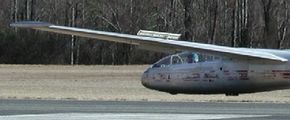Landing
Landing a glider is much like landing a conventional plane, except there is usually a single small wheel located directly under the pilot. The wings on gliders are very strong, and the tips are reinforced to prevent damage in case they scrape along the ground during a landing. Even so, pilots can usually manage to keep both wing tips off the ground until the plane has slowed sufficiently (kind of like riding a fast bike down the runway). Glider tails typically have a tiny wheel that prevents the tail from scraping while on the ground.
When landing the glider, the pilot needs to be able to control the glide path (the rate of descent relative to distance traveled) in order to bring the glider down in the right location. The pilot has to be able to reduce the amount of lift produced by the wings without changing the speed or attitude of the glider. He does this by deploying spoilers on each wing. The spoilers disrupt the airflow over the wing, drastically reducing the lift it produces and also increasing the drag.
Advertisement
